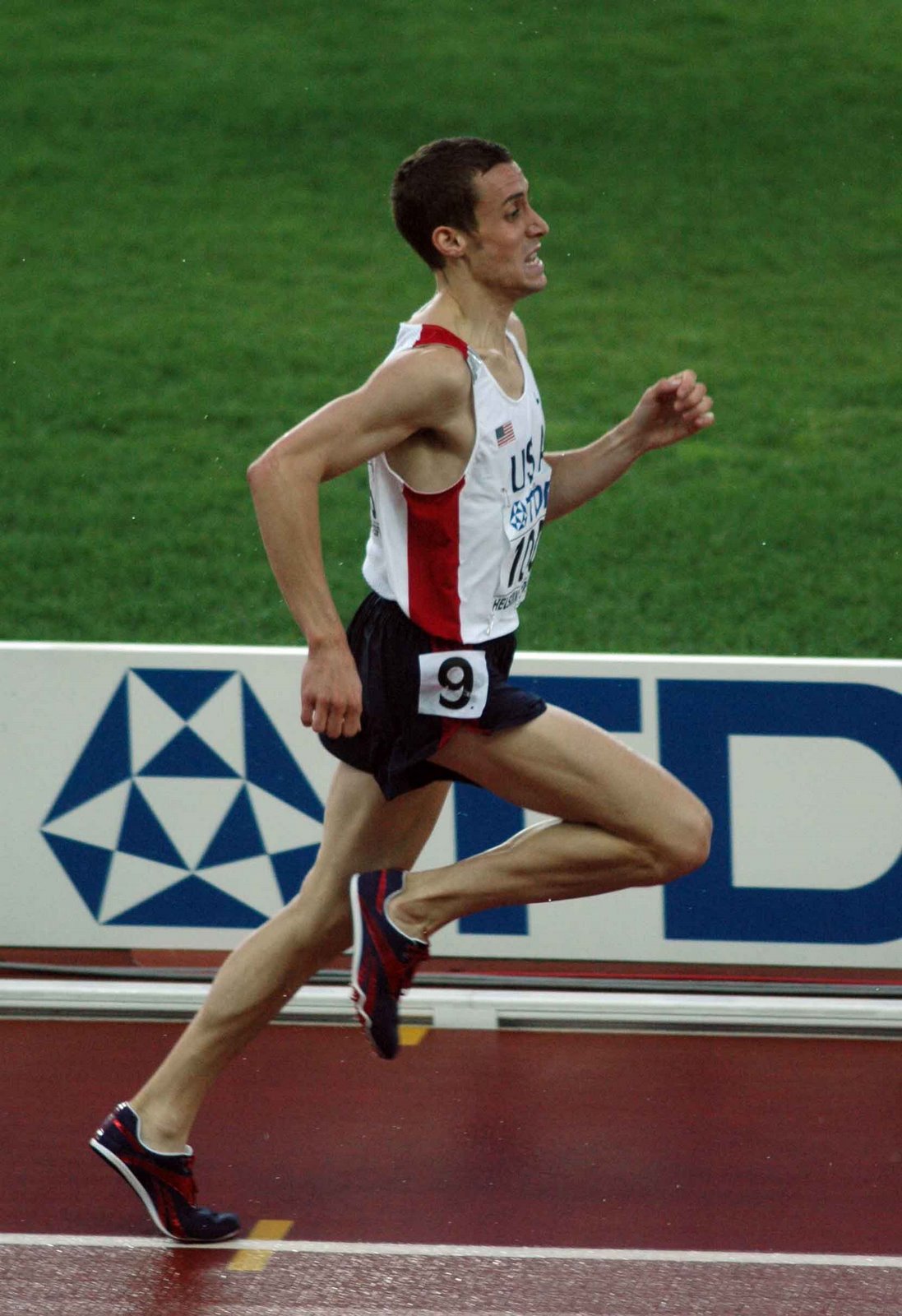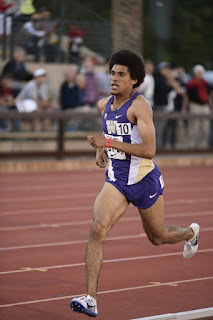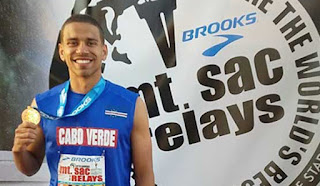Where (or who) is the future of track in the US? GUEST COLUMNIST: Chris Lukezic

I'm turning over the reigns of paulmerca.blogspot.com to 1500 meter runner Chris Lukezic (left/ file photo by Paul Merca) for perhaps one of the more thoughtful pieces on the sport of track and field that I've seen from a current athlete. Chris is a product of this state, having graduated from Auburn HS in 2002. He's no slouch on the track, owning a resume that reads like this:
2006 USA Indoor champion; Two-time U.S. Junior 1,500m champ; 2005 USA Outdoor 1,500m runner-up; 2005 Big East Conference champ; 5-time NCAA All-American.
I happened to read excerpts of this from the web site runnerville.com. Right then and there, I knew that this was a piece that had to be on this site, as many of the points Chris brings across are points that I've thought about for a long, long time.
While running is one of this country's leading participatory sports, I honestly don't think that beyond the Olympics, the majority of the general running public knows who the top runners are in the world, much less this country.
I feel, as does Chris, that there is a serious lack of connection between the elite runners and the masses, and that in order for this sport to be relevant, something has to happen to make track and field--and running--more than a once-every-four-year proposition.
Here's Chris' piece, courtesy of fifteenhundred.com:
This post stems from long running discussions I have had with a number of people regarding the marketing and brand positioning of the sport. It is easy to sit back and criticize the IAAF and the USATF for failing to make the moves necessary to address the evolving face of sports, media, and fans.
Track needs to continually evolve, like any efficient business does, to the demands of the marketplace. This is something the IAAF and the USATF have been very slow to do. The USATF needs to refocus the professional side of the sport towards a revenue generating operation. The limitation of the current non-profit structure has only limited USATFs ability to commit itself to a proper brand image and marketing strategy that can contribute to increased interest in the sport and the further “professionalization” of the sport in the United States. The search for a new CEO at the USATF has brought the organization to a monumental crossroad. One road leads towards more of the same and a glacial attempt to catch up and emulate what other sports knew 5 years ago. The other road, which can only be traversed by bringing in someone from outside the established organization, leads to a restructuring and probably a few years of growing pains to implement a corporate style structure into the financial, branding, and marketing functions of the USATF.
The restructuring of the USATF has to begin with a full separation in operations of the professional and non-professional aspects of the sport. They could go as far as to completely eliminate USATF from any relation to professional track and field in the US and name it something else. This is not because the USATF has failed at what is has done. It just hasn’t progressed as fast as the market has. The separation would be needed to instill a unified identity for each aspect of the sport that all employees and athletes can stand behind. By separating and restructuring it eliminates any confusion or muddling of the core values/identity of the professional side of the sport. One side of the organization would remain a non-profit and focus on all youth and masters efforts. This side of the organization would also be the national governing body of track and field for all “non-professional” activities. This is similar to what already happens with the elite athlete department run by a separate group of people. However, I’m calling for something more marked. The reasoning behind creating a new group (maybe even a name change?) is to fully focus business efforts for each group. Youth and Masters runners who participate are one market that the USATF has to consider. However the elite side of the sport needs to focus itself towards fans. Participators are not necessarily fans. The disconnect between people who run and people who watch running is HUGE and fully demonstrates this point. There aren’t many sports that people participate in and still take no interest in outside of their own participation.
To focus on the fans, professional track and field in the United States needs its own organization and its own structure, distinct and separate from what we currently have. This is necessary for the elite side of the sport to find its voice. A comprehensive brand overhaul is needed first. Track is unidentifiable. Cycling has its romanticism, baseball its history, and basketball its urban swagger. What does track have? The Olympics are an obvious answer, but anyone who runs knows there is more to the sport than that. Track and running needs to find that voice and then market it to the point consumers (ie. fans) can identify with it. We can’t confuse consumers with mixed or inconsistent messages.
Consumers want images, they want ideas, and they want a culture that they can project themselves into. Often times this sport underestimates the power that good marketing and branding can have in drawing in interest in the sport. Track needs to reinvent itself in a more glamorous light. This means better branding of the USATF, better marketing of its core message/voice, and tweaking the way meets are run. Sponsors need to become more visible as well. The USATF needs to make their sponsors a part of their strategy. We can’t just paste a Toyota logo up around the track and call it a good sponsorship strategy. We need to draw those sponsors in with inclusive strategies that treat those sponsors like they are part of the organization (which they truly are). The athletes need to be utilized through more community interaction and local marketing of individual athletes. When I meet people (even briefly) in DC and I tell them I am going to be racing on ESPN at the New York Grand Prix they are far more likely to watch because I have given them a reason to watch. I’m a local and I’m someone they met that they can root for. I’ve given them a reason to tune in. For instance, I don’t necessarily love college basketball, but I love to watch Georgetown play and I won’t miss a game. That is because I have a reason to watch. Track needs to give fans the same reasoning. Finally the USATF needs to open up athlete sponsorship by changing logo size rules, race number configuration (make meet sponsor logo bigger and athlete name smaller). Fans on TV should be able to see that Reebok sponsors me. However under the current rules the size of the logo is limited and nearly impossible to see unless you are on the track.
Obviously a few pages of writing (although I would call this blogging more than writing due to its free form nature) only really scratch the surface of the possibilities for the sport. However, I felt it was important to add something to this discussion. With a lack of mainstream media coverage I am hoping that the voices of people intimately connected to the sport will be heard and considered. I believe the more the sport is discussed the more likely it is that really good ideas will be hatched.
As a post script to this post I am adding a few points that my father brought up in an email to me. He mentions the USGA and the PGA as a prime example of how separate organizations can operate independently yet use their synergies to promote both the amateur and the professional sides of the sport. The USGA governs the sport at all levels and promotes the game to scratch golfers and +20 handicappers alike. The PGA, as the professional arm of the sport, deals with its own marketing, branding, tournaments, and the biggest major championship of the year. On top of that they protect, utilize, and encourage all of the players within the association. The PGA has done a very good job of supporting the guys at the bottom of the leader board as much as they do the guys at the top. If anything the strength of the PGA is in its overwhelming depth of quality players. The USATF and the IAAF alike have very little if any system in place to give the guy fresh out of college the support necessary to spend 4 or 5 years training and racing before reaching their peak in their mid to late 20’s. This is where having a separate professional organization in the US can make a difference. The USATF puts a lot of time and energy into their grassroots youth programs but hasn’t developed a system that can do the same for elites. So far it has been private organizations that have taken the initiative to do this (Hansons, Zap, OTC etc.). So how does the USATF support those organizations? I really don’t know but I’m putting it out there. We need a CEO at the USATF who can think creatively about the whole system and develop comprehensive solutions. The USATF pays well enough that they can find the talent to do this. The question really is, will they look outside of the establishment to find a leader? The role of CEO of the USATF should not be viewed as a reward for minding ones p’s and q’s within the organization and showing “leadership” qualities. In my opinion, the first fault of the USATF is looking within the sport for a leader. We need a fresh perspective.


Comments